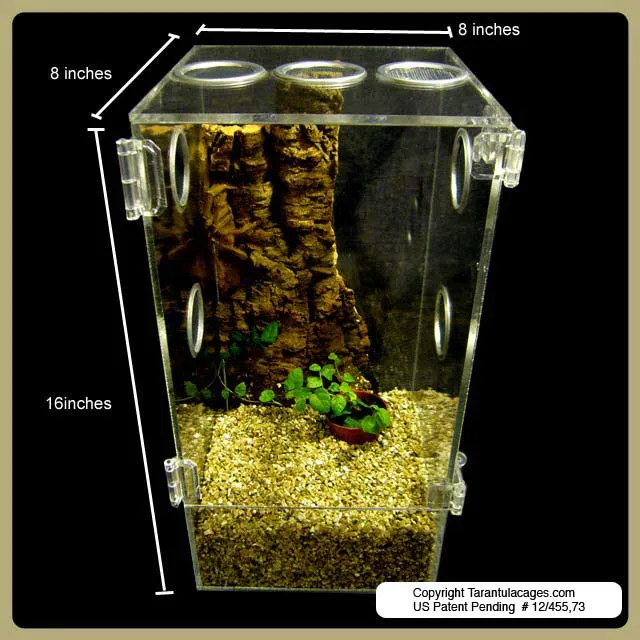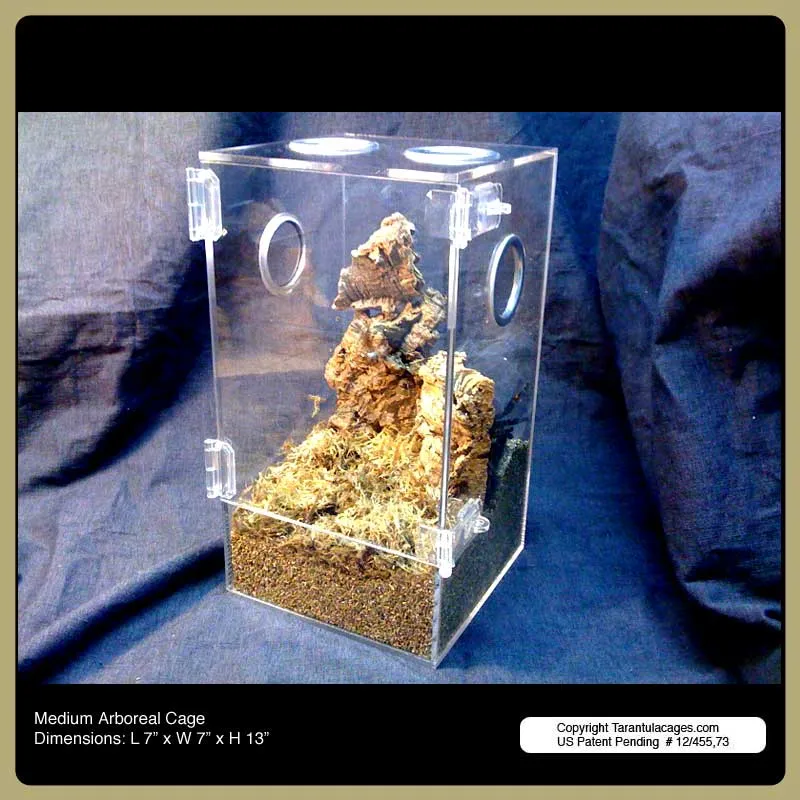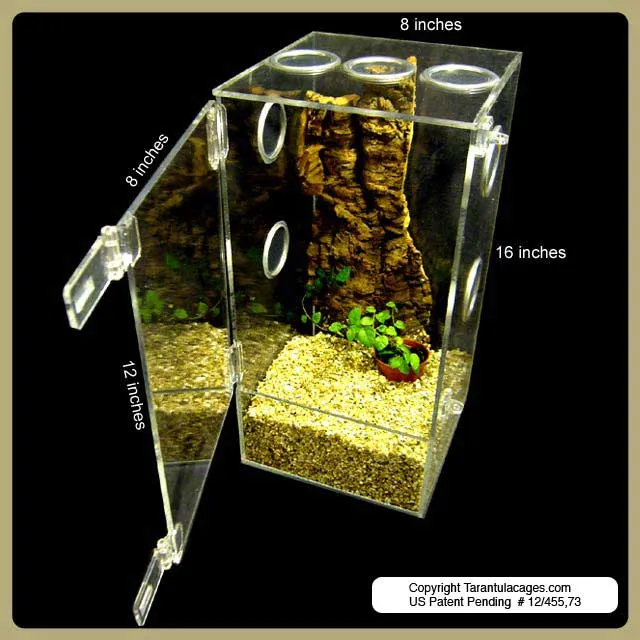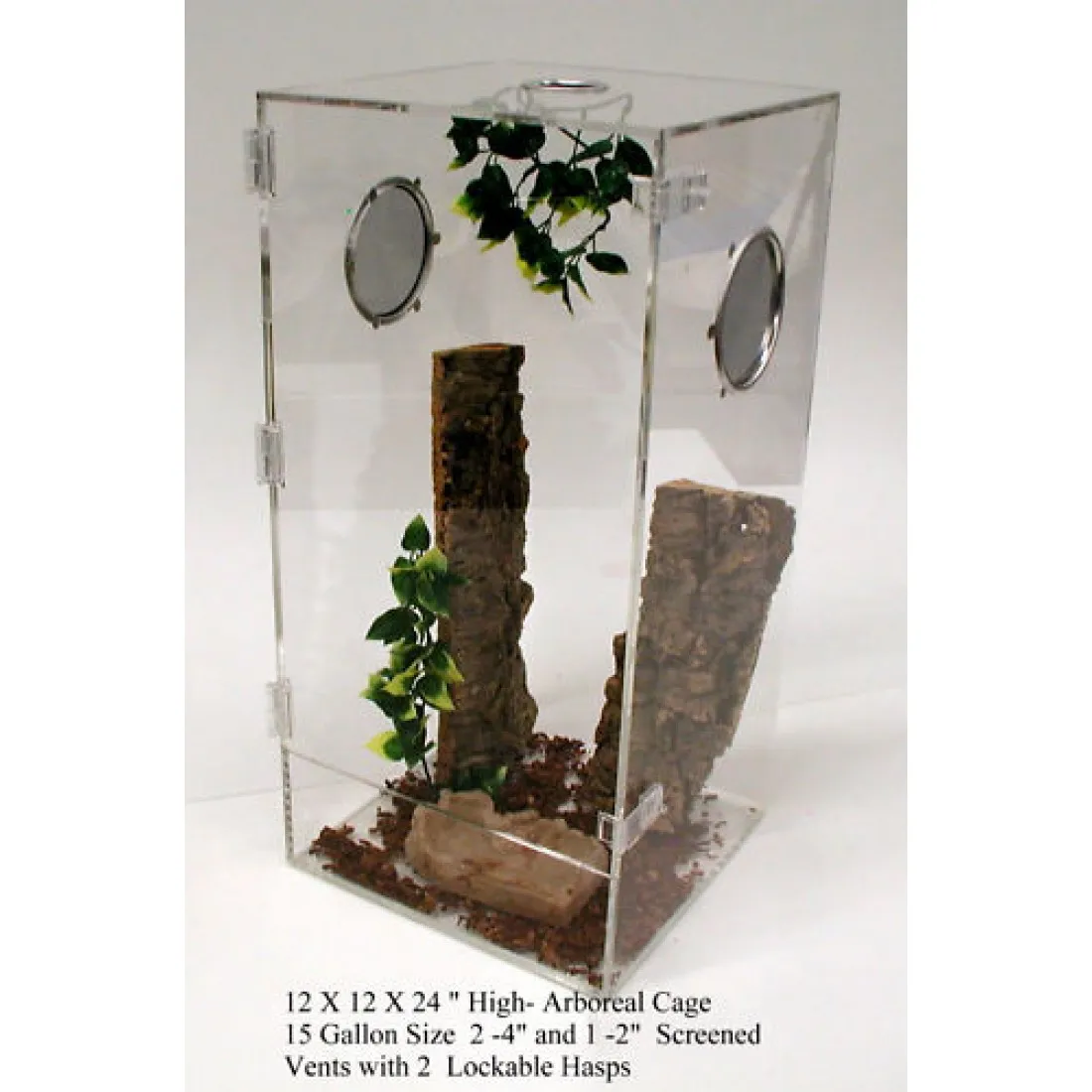Top 7 Arboreal Tarantula Cages For Sale
Finding the right arboreal tarantula cage for sale is crucial for your spider’s health and happiness. Arboreal tarantulas, unlike their terrestrial counterparts, require a vertical habitat that allows them to climb and explore. This guide provides a comprehensive overview of the top 7 arboreal tarantula cages available, helping you make an informed decision. We’ll delve into the essential features to consider, including size, ventilation, material, and ease of maintenance. Whether you’re a seasoned tarantula keeper or a beginner, this guide will assist you in selecting the perfect enclosure for your pet. The goal is to create a comfortable, secure, and visually appealing home for your arboreal tarantula.
What to Look for in Arboreal Tarantula Cages
When searching for arboreal tarantula cages for sale, several key factors should guide your choice. The primary considerations include size and dimensions, ventilation, and the materials used in construction. A well-designed cage will provide ample space for climbing and movement, sufficient airflow to prevent mold and maintain the correct humidity level, and durable materials that can withstand the tarantula’s environment. The cage should also be easy to access for feeding, watering, and cleaning, ideally featuring a secure lid to prevent escape. Considering these aspects ensures you create a safe and enriching environment for your arboreal tarantula, supporting its well-being.
Size and Dimensions for Arboreal Tarantula Cages

The size and dimensions of the tarantula enclosure are critical for your pet’s well-being. Arboreal tarantulas need a vertical space to climb and feel secure. A general guideline is to provide a cage that is at least three times the tarantula’s leg span in height, and twice the leg span in width and depth. For instance, a tarantula with a 6-inch leg span would ideally need an enclosure that is at least 18 inches tall. Avoid cages that are too large for smaller tarantulas, as it can make them feel insecure, and make it harder to find their food. Also consider the growth potential of your tarantula and select an enclosure that will accommodate its adult size.
Ventilation Needs for Arboreal Tarantula Cages
Proper ventilation is essential for the health of your arboreal tarantula. Adequate airflow prevents the buildup of excessive humidity, which can lead to mold growth and respiratory issues. The enclosure should have cross-ventilation, with vents located on opposite sides of the cage to allow air to flow freely. Mesh or perforated lids and side panels are common features. Ensure the ventilation is fine enough to prevent escape but coarse enough to allow for proper airflow. Avoid cages with minimal ventilation, as they can create a stagnant environment that is harmful to your tarantula. Regularly check the ventilation openings to ensure they are free from obstructions.
Material Considerations for Arboreal Tarantula Cages
The material of the tarantula cage plays a significant role in its durability, safety, and ease of maintenance. Glass and acrylic are popular choices due to their clarity, allowing for easy viewing of your pet. They are also relatively easy to clean. However, glass cages can be heavy and more fragile, while acrylic can scratch. Plastic enclosures are another option, often more lightweight and cost-effective, but they may not offer the same level of clarity. Regardless of the material, ensure the cage is non-toxic and constructed to withstand the tarantula’s potential digging and climbing behaviors. The lid must be secure and escape-proof. Choose a material that allows for easy cleaning and disinfection, ensuring a healthy environment for your tarantula.
Top 7 Arboreal Tarantula Cages Reviewed

Selecting the right arboreal tarantula enclosure from all the arboreal tarantula cages for sale can be a challenge. We’ve compiled a list of the top 7 arboreal tarantula cages, each offering unique features and benefits. This section provides a detailed overview of each enclosure, considering factors like size, ventilation, material, and overall suitability for arboreal tarantulas. From budget-friendly options to premium choices, we’ll highlight the pros and cons of each cage to assist you in making an informed decision. Review the specifications and features to identify the best fit for your specific needs and your tarantula’s requirements. The goal is to provide a comprehensive guide to help you choose the ideal habitat.
Cage 1 Overview and Features
Cage 1 is a top choice for its excellent ventilation and spacious design. This enclosure features a clear acrylic construction, providing excellent visibility while being lightweight and durable. The hinged lid is secure and easy to access, and the ventilation is carefully designed to promote airflow without compromising humidity levels. This cage is ideal for medium to large arboreal tarantulas. The ample height allows for the addition of climbing decor, creating an enriching environment for your pet. Its easy-to-clean surface simplifies maintenance, and the overall build quality ensures long-lasting performance.
Cage 2 Overview and Features
Cage 2 stands out for its affordability and user-friendly design. This cage is often made from durable plastic, which is a budget-friendly option. It offers a good balance of ventilation and humidity control, making it suitable for a variety of arboreal tarantula species. The cage’s design includes a secure locking mechanism on the lid, preventing accidental escapes. While it may not offer the same premium features as some other cages, Cage 2 is an excellent choice for beginners. It provides a practical and safe environment for your tarantula, emphasizing ease of use and affordability.
Cage 3 Overview and Features

Cage 3 is renowned for its superior ventilation and aesthetic appeal. Constructed from high-quality glass, this enclosure offers crystal-clear visibility and a sleek design. Its ventilation system includes strategically placed vents to ensure optimal airflow, preventing excessive humidity buildup and supporting the health of your tarantula. The glass construction is easy to clean and maintain, and it provides a visually stunning habitat. Cage 3 often includes features like a built-in feeding access and pre-drilled holes for mounting decor, enhancing convenience. This cage is a great option for experienced keepers who appreciate both functionality and aesthetics.
Cage 4 Overview and Features
Cage 4 offers a unique combination of features, focusing on providing an enriching environment for arboreal tarantulas. It features a tall, vertical design, perfect for arboreal species that enjoy climbing. The cage is made from durable materials and incorporates multiple entry points for ease of access and maintenance. The design often includes features like built-in backgrounds and ledges to encourage natural behaviors. This enclosure also includes excellent ventilation to support the tarantula’s health. Cage 4 is a great choice for keepers who want to create a stimulating habitat that mimics the natural environment of their tarantula.
Cage 5 Overview and Features
Cage 5 is designed with convenience in mind. This cage typically features a lightweight plastic construction, making it easy to handle and transport. It incorporates user-friendly features such as a secure lid with a locking mechanism and easy-access feeding ports. The ventilation is well-designed, balancing airflow and humidity. Cage 5’s practical design makes it ideal for keepers who value ease of use and efficient maintenance. Its robust construction ensures the safety of your tarantula. This enclosure often comes in various sizes, allowing you to choose one that suits your tarantula’s specific needs and growth stage.
Cage 6 Overview and Features

Cage 6 offers a premium experience, often constructed from high-quality materials. This enclosure features a sleek, modern design with exceptional clarity. Its ventilation system is meticulously designed to maintain optimal conditions, and the secure locking mechanism provides enhanced safety. Cage 6 often includes innovative features, such as built-in humidity gauges and temperature sensors, providing valuable insights into the enclosure’s environment. It’s a great option for experienced keepers who seek the best in quality and design. This cage is ideal for those prioritizing aesthetics and advanced functionality.
Cage 7 Overview and Features
Cage 7 is an excellent choice for beginners and experienced keepers alike. This cage combines affordability with essential features, providing a safe and comfortable habitat. It typically features a durable, easy-to-clean design. Ventilation is well-balanced, and the secure lid ensures your tarantula stays safely inside. Cage 7 is often available in various sizes, to accommodate different species and growth stages. Its simplicity and functionality make it a reliable option for anyone looking for a straightforward, effective tarantula enclosure.
Maintaining and Cleaning Arboreal Tarantula Cages
Proper maintenance is crucial to ensure the well-being of your arboreal tarantula and the longevity of its enclosure. Regular cleaning helps prevent the buildup of waste products, mold, and harmful bacteria. Spot-clean the cage as needed, removing any uneaten food and visible debris. Change the substrate regularly, typically every few months, or more frequently if the enclosure gets heavily soiled. Regularly inspect the cage for any signs of damage and replace any worn-out components. Always use appropriate cleaning solutions that are safe for your tarantula and its environment. Proper maintenance will keep your tarantula healthy and the cage looking its best.
Importance of Humidity and Temperature

Maintaining the correct humidity and temperature levels is essential for your arboreal tarantula’s health. Most arboreal tarantulas require a moderate humidity level, which can be achieved by misting the enclosure with water or providing a water dish. Use a hygrometer to monitor the humidity levels. The ideal temperature range varies by species, but generally, arboreal tarantulas thrive in temperatures between 75°F and 85°F (24°C to 29°C). Use a thermometer to monitor the temperature. Avoid placing the cage in direct sunlight or near heat sources, as this can cause excessive heat and dehydration. Proper humidity and temperature levels will promote the health and well-being of your tarantula.
Cleaning Frequency and Methods
The frequency of cleaning and the methods used will depend on the specific needs of your tarantula and the type of enclosure. Spot-clean the cage regularly, removing any visible waste and uneaten food. A full cleaning should be performed every few months or as needed. Remove your tarantula to a temporary holding container. Remove the substrate, clean the cage with warm water and a mild, non-toxic cleaning solution. Rinse thoroughly to remove any traces of cleaning solution. Allow the enclosure to dry completely before returning the substrate and your tarantula. Using the right methods helps maintain a clean and healthy environment.
Where to Buy Arboreal Tarantula Cages For Sale
Finding arboreal tarantula cages for sale can be easy with the right information. Pet stores specializing in reptiles and exotic animals often have a selection of cages and enclosures. Online retailers, such as Amazon and specialized reptile supply websites, offer a wide variety of options. Consider local reptile shows or expos, which can provide opportunities to see and purchase cages in person. Before making a purchase, compare prices, read reviews, and assess the cage’s features to ensure it meets your needs and your tarantula’s requirements. Remember to prioritize the safety and well-being of your pet.
